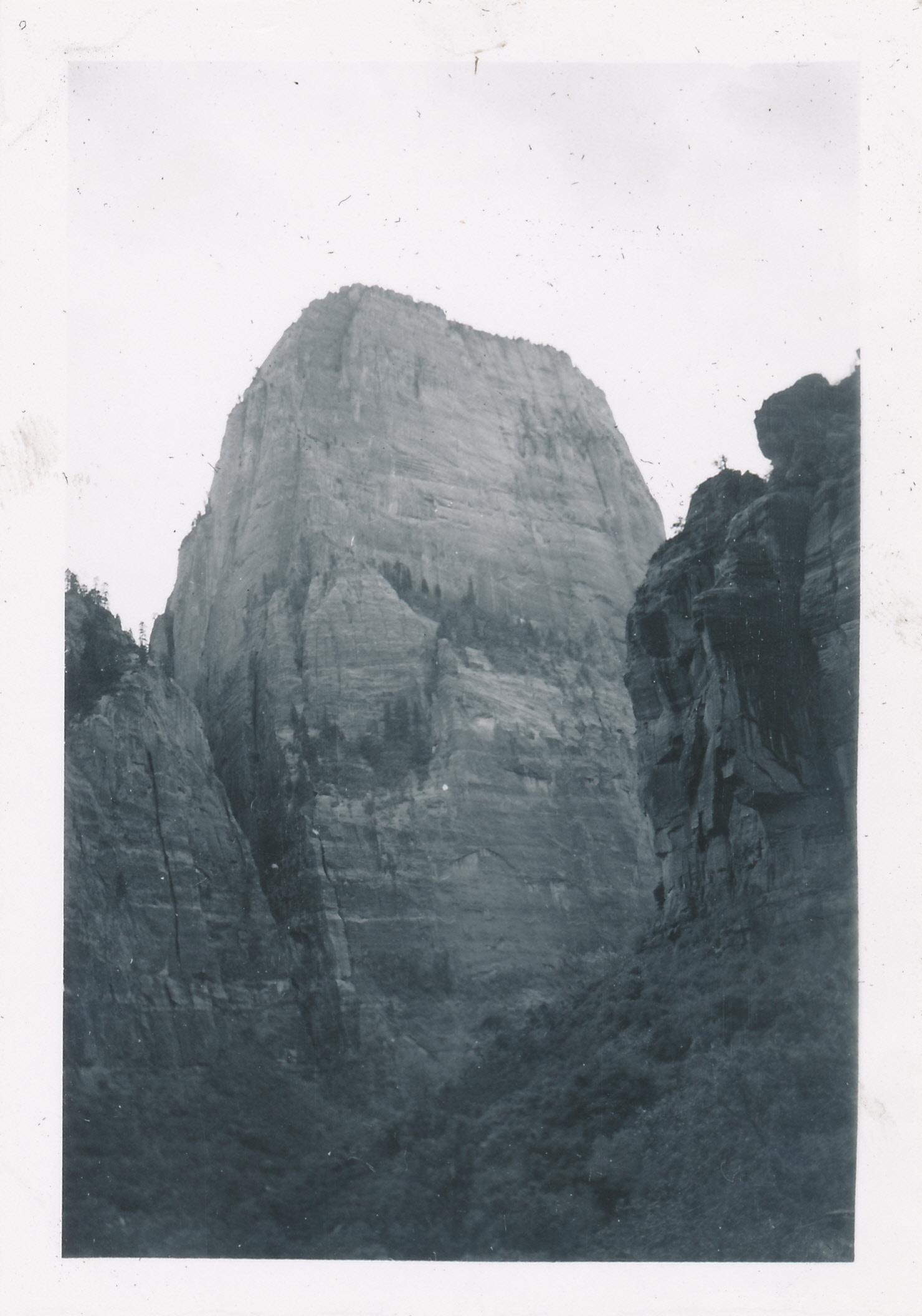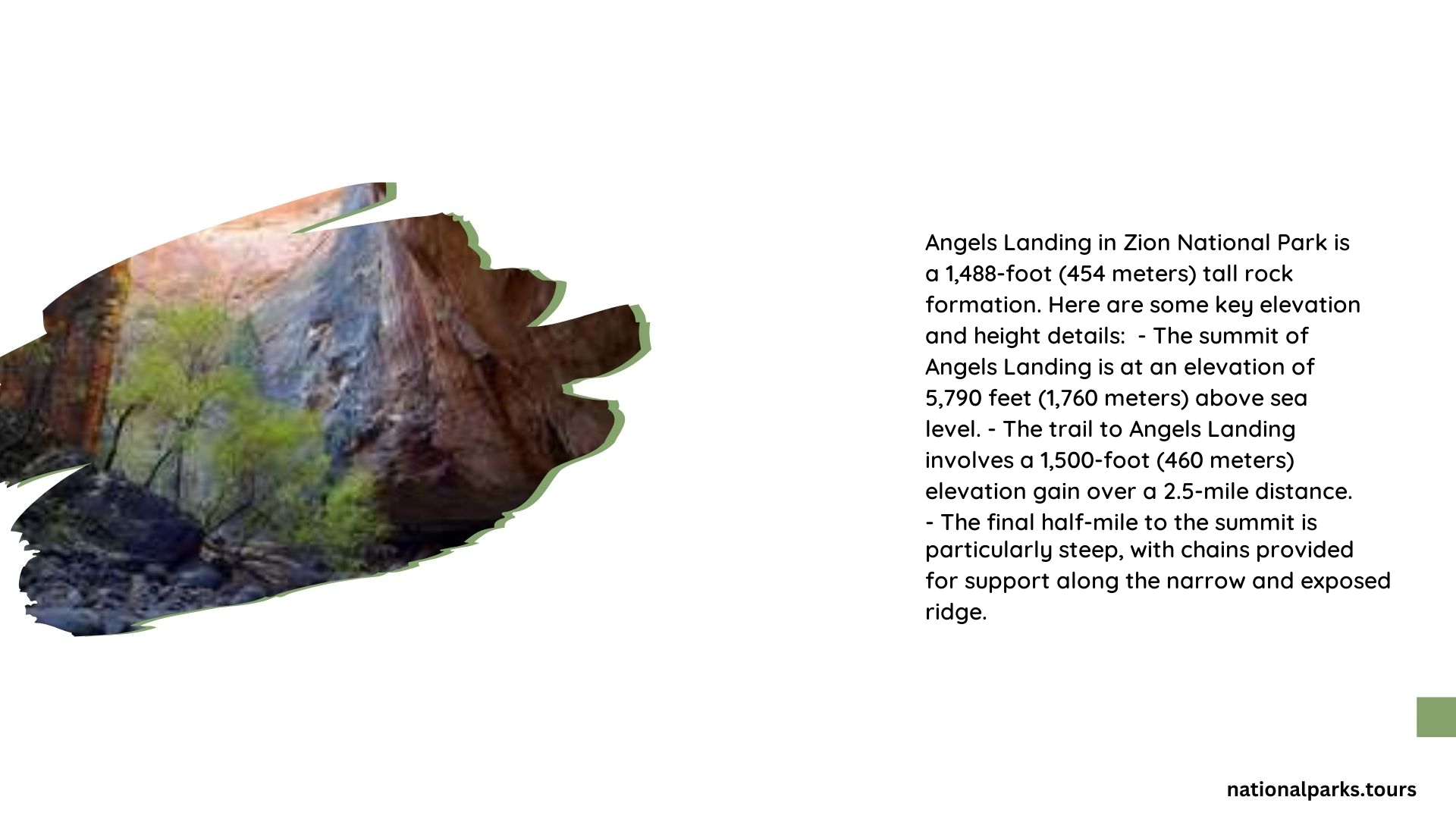Angels Landing in Zion National Park stands at an impressive elevation of 5,790 feet (1,760 meters) above sea level. This iconic hike offers a challenging ascent with a total elevation gain of approximately 1,500 feet (460 meters) from the trailhead to the summit. The final half-mile stretch features steep drop-offs of 800 to 1,000 feet on either side, making it a thrilling yet daunting experience for hikers.
What is the Summit Elevation of Angels Landing?

The summit of Angels Landing reaches an elevation of 5,790 feet (1,760 meters) above sea level. This towering monolith provides breathtaking panoramic views of Zion Canyon and the surrounding landscape. To put this elevation into perspective:
- It’s roughly equivalent to 1,930 yards or 1.1 miles in height
- The summit is about 54 times taller than the Statue of Liberty (without its pedestal)
- It’s approximately half the height of Mount Vesuvius in Italy
The elevation of Angels Landing contributes significantly to its status as one of the most sought-after hikes in Zion National Park, offering a unique vantage point over the dramatic red rock formations and deep canyons below.
How Much Elevation Gain Does the Angels Landing Trail Have?

The Angels Landing trail presents hikers with a substantial elevation gain of approximately 1,500 feet (460 meters) from the trailhead to the summit. This elevation change occurs over a distance of about 2.5 miles (4 km) one-way, resulting in a steep and challenging ascent. To better understand this elevation gain:
- It’s equivalent to climbing about 150 stories in a building
- The gain is roughly the height of the Empire State Building
- It’s comparable to ascending 5,000 stairs
The elevation gain is distributed throughout the trail, with some sections being steeper than others. Here’s a breakdown of the trail’s elevation profile:
| Trail Section | Approximate Elevation Gain |
|---|---|
| West Rim Trail to Scout Lookout | 1,000 feet (305 meters) |
| Scout Lookout to Summit | 500 feet (152 meters) |
This significant elevation gain over a relatively short distance contributes to the trail’s difficulty and requires hikers to be in good physical condition.
What is the Vertical Drop on the Final Stretch of Angels Landing?
The most notorious section of the Angels Landing hike is the final half-mile stretch leading to the summit. This segment, often referred to as the “spine” or “Hogsback,” features vertigo-inducing drop-offs of 800 to 1,000 feet (244 to 305 meters) on either side of the narrow ridge.
To visualize this vertical drop:
- It’s roughly equivalent to the height of a 70 to 90-story skyscraper
- The drop is about twice the height of the Washington Monument
- It’s comparable to 2-3 football fields stood on end
This extreme exposure contributes to the trail’s reputation as one of the most dangerous hikes in the United States. The National Park Service has installed chains along this section to assist hikers, but the sheer drop-offs and narrow path still pose significant risks.
How Does Angels Landing Compare to Other Peaks in Zion National Park?
While Angels Landing is undoubtedly one of the most famous hikes in Zion, it’s not the highest point in the park. Here’s how it compares to other notable peaks:
- Horse Ranch Mountain: 8,726 feet (2,660 meters)
- North Guardian Angel: 7,395 feet (2,254 meters)
- Mount Kinesava: 7,285 feet (2,220 meters)
- Angels Landing: 5,790 feet (1,760 meters)
Despite not being the tallest, Angels Landing’s prominence and accessibility make it a standout feature in Zion’s landscape.
What Factors Contribute to Angels Landing’s Perceived Height?
Several factors contribute to Angels Landing feeling higher than its actual elevation:
- Relative Elevation: The trail begins at a much lower elevation in Zion Canyon, making the ascent feel more dramatic.
- Exposure: The sheer drop-offs on the final stretch create a sense of extreme height and vulnerability.
- Visual Impact: The monolithic structure stands out prominently against the surrounding canyon walls.
- Physical Exertion: The strenuous nature of the hike can make the ascent feel more significant than the actual elevation gain.
How Does Weather Affect the Perception of Angels Landing’s Height?
Weather conditions can significantly impact how hikers perceive the height and challenge of Angels Landing:
- Wind: Strong gusts at higher elevations can increase the sense of exposure and height.
- Cloud Cover: Low-hanging clouds can obscure the summit, making it appear higher or more mysterious.
- Temperature: Cooler temperatures at higher elevations can create a noticeable climate change during the ascent.
- Visibility: Clear days offer expansive views that emphasize the elevation, while hazy conditions might diminish the perceived height.
What Safety Measures Address the Height-Related Risks on Angels Landing?
Given the significant elevation and exposure on Angels Landing, several safety measures are in place:
- Chain Supports: Metal chains are anchored along the most exposed sections to provide handholds.
- Warning Signs: Clear signage alerts hikers to the dangers of the trail.
- Permit System: A permit is required to hike the final section, helping to manage crowds and enhance safety.
- Trail Maintenance: Regular upkeep ensures the path and safety features remain in good condition.
- Ranger Presence: Park rangers often patrol the trail to assist hikers and enforce safety rules.
How Does the Elevation of Angels Landing Affect Hiking Difficulty?
The elevation of Angels Landing significantly impacts the difficulty of the hike:
- Altitude Effects: Some hikers may experience mild altitude-related symptoms at the summit.
- Physical Demand: The steep elevation gain requires good cardiovascular fitness and endurance.
- Mental Challenge: The exposure at height can be psychologically demanding for many hikers.
- Time Requirement: The elevation gain necessitates a slower pace, extending the duration of the hike.
- Weather Exposure: Higher elevations can mean more extreme weather conditions, particularly wind and sun exposure.
In conclusion, the height of Angels Landing in Zion National Park, with its summit at 5,790 feet and a challenging 1,500-foot elevation gain, combined with extreme exposure on the final stretch, creates a hiking experience that is as thrilling as it is demanding. The trail’s elevation profile, coupled with its unique geological features, contributes to its status as one of the most iconic and sought-after hikes in the United States.
References:
1. Angels Landing – Wikipedia
2. Angel’s Landing – Terrain360
3. Ultimate Guide to the Angels Landing Hike in Zion National Park – She Dreams of Alpine
